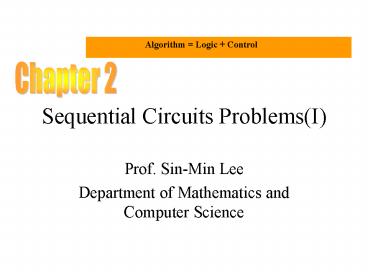Sequential Circuits Problems(I) - PowerPoint PPT Presentation
1 / 35
Title:
Sequential Circuits Problems(I)
Description:
When D-type flip-flops are employed, the input equations are obtained directly ... This is not the case for JK and other types of flip-flops. ... – PowerPoint PPT presentation
Number of Views:30
Avg rating:3.0/5.0
Title: Sequential Circuits Problems(I)
1
Sequential Circuits Problems(I)
Algorithm Logic Control
Chapter 2
- Prof. Sin-Min Lee
- Department of Mathematics and Computer Science
2
(No Transcript)
3
(No Transcript)
4
(No Transcript)
5
(No Transcript)
6
(No Transcript)
7
(No Transcript)
8
(No Transcript)
9
(No Transcript)
10
(No Transcript)
11
(No Transcript)
12
(No Transcript)
13
(No Transcript)
14
(No Transcript)
15
(No Transcript)
16
We wish to design a synchronous sequential
circuit whose state diagram is shown in Figure.
The type of flip-flop to be use is J-K
Two flip-flops are needed to represent the four
states and are designated Q0Q1. The input
variable is labelled x.
17
. Excitation table for JK flip-flop
Excitation table of the circuit
18
The simplified Boolean functions for the
combinational circuit can now be derived
19
(No Transcript)
20
(No Transcript)
21
(No Transcript)
22
(No Transcript)
23
(No Transcript)
24
- How do we determine the combinatorial ciccuit?
- This circuit has three inputs, I, R, and the
current A. - It has one output, DA, which is the desired next
A. - So we draw a truth table, as before.
- For convenience I added the label Next A to the
DA column - But this table is simply the truth table for the
combinatorial circuit.
25
(No Transcript)
26
(No Transcript)
27
A divide-by-three counter which outputs one 1 for
every 3 1's seen as input (not necessarily in
succession.) After outputting a 1, it starts
counting all over again. 1. To build this, will
need three states, corresponding to 0, 1, or 2
1's seen so far.
28
(No Transcript)
29
Designing with JK Flip-Flops
- The design of a sequential circuit with other
than the D type is complicated by the fact that
the flip-flop input equations for the circuit
must be derived indirectly from the state table.
When D-type flip-flops are employed, the input
equations are obtained directly from the next
state. This is not the case for JK and other
types of flip-flops. In order to determine the
input equations for these flip-flops, it is
necessary to derive a functional relationship
between the state table and the input equations.
30
Flip-Flop Excitation Tables
- A table that lists the required inputs for a
given change of state is known as an excitation
table. Example of an excitation table is shown
below
31
Flip-Flop Excitation Tables (cont)
- The excitation table show four different types
of flip-flops. Each table has a column for the
present state Q(t), a column for the next state
Q(t 1), and a column for each flip-flop input
to show how the required transition is achieved.
The symbol X in the table represents a dont-care
condition, which means that it does not matter
whether the input is 0 or 1.
32
Flip-Flop Excitation Tables (cont)
- The excitation table for the D flip-flop shows
that the next state is always equal to the D
input and is independent of the present state.
This can be represented algebraically - D Q(t 1)
33
Design Procedure
- The design procedure for sequential circuits with
JK flip-flops is the same as that for sequential
circuits with D flip-flops, except that the input
equations must be evaluated from the
present-state to next-state transition derived
from the excitation table.
34
Design Procedure (cont)
- The advantage of using JK-type flip-flops when
designing sequential circuits is that there are
so many dont-care entries indicates that the
combinational circuit for the input equations is
likely to be simpler, because dont-care minterms
usually help in obtaining simpler expressions.
35
Design Procedure (cont)
- In order to perform the simulation, a clock, as
well as the input signals R and X, is required.
In doing the simulation of any sequential
circuit, sufficient time must be provided in the
clock period for each of the following - 1. All flip-flops and inputs to change
- 2. The effects of these changes to propagate
through the combinational logic of the circuit
to the flip-flop inputs and - 3. The setup of the flip-flops for the next
clock edge to occur.































